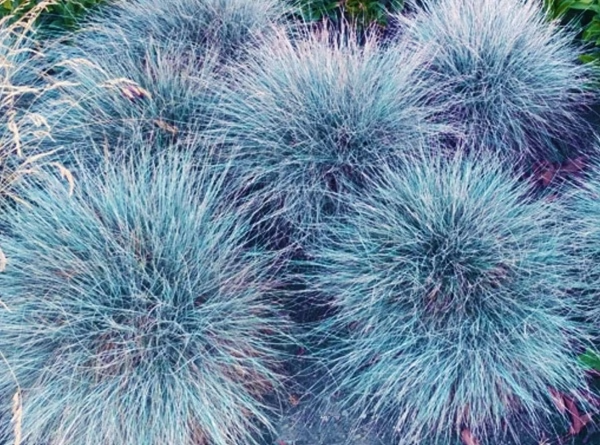
Blue Fescue
Botanical Name
:
Festuca glauca
Plant Type
:
Ornamental grass, perennial
Seasons
:
Best planted in spring or early fall
Sun Level
:
6+ hours of full sun, tolerates partial shade (at least 4 hours) but full sun is best for color
Ideal Soil Temperature for Planting
:
60-70°F (15-21°C)
Soil Type
:
Well-draining, sandy or loamy soil. Avoid heavy clay, which retains too much moisture
Hardiness Zones
:
4–8 (USDA)
Germination
:
14–21 days at optimal soil temperature (60–70°F)
P.H. Level
:
5.5–7.5
Water/Irrigation
:
Water deeply during the first few weeks to establish roots. Once established, it’s drought-tolerant
Fertilization
:
Light fertilization with a balanced, slow-release fertilizer in spring
Habit
:
Clumping, mounding, dense foliage with fine texture
Final Plant Height
:
8–12 inches (20–30 cm), (inflorescences may reach 14–18 inches)
Spread
:
10–12 inches wide
Spacing
:
8–10 inches apart for dense ground cover
Flowers
:
Produces small, inconspicuous tan or light brown flower spikes in early summer
Attracts
:
Butterflies; deer-resistant
Uses
:
Rock gardens, borders, containers, drought-tolerant gardens, and ground cover
Companions
:
Sedum, Lavender, Russian sage, Black-eyed Susan, Coreopsis
Pruning
:
Trim back dead or faded foliage in early spring to encourage new growth. Avoid cutting into the crown
Toxicity
:
Non-toxic to humans and pets
Pests
:
Generally pest-resistant
Diseases
:
Resistant to most diseases. Avoid overwatering to prevent root rot
Expert Care Tips
:
Divide clumps every 2–3 years in early spring to maintain vigor and prevent center die-back. This also helps propagate new plants
Botanical Name
:
Festuca glauca
Plant Type
:
Ornamental grass, perennial
Seasons
:
Best planted in spring or early fall
Sun Level
:
6+ hours of full sun, tolerates partial shade (at least 4 hours) but full sun is best for color
Ideal Soil Temperature for Planting
:
60-70°F (15-21°C)
Soil Type
:
Well-draining, sandy or loamy soil. Avoid heavy clay, which retains too much moisture
Hardiness Zones
:
4–8 (USDA)
Germination
:
14–21 days at optimal soil temperature (60–70°F)
P.H. Level
:
5.5–7.5
Water/Irrigation
:
Water deeply during the first few weeks to establish roots. Once established, it’s drought-tolerant
Fertilization
:
Light fertilization with a balanced, slow-release fertilizer in spring
Habit
:
Clumping, mounding, dense foliage with fine texture
Final Plant Height
:
8–12 inches (20–30 cm), (inflorescences may reach 14–18 inches)
Spread
:
10–12 inches wide
Spacing
:
8–10 inches apart for dense ground cover
Flowers
:
Produces small, inconspicuous tan or light brown flower spikes in early summer
Attracts
:
Butterflies; deer-resistant
Uses
:
Rock gardens, borders, containers, drought-tolerant gardens, and ground cover
Companions
:
Sedum, Lavender, Russian sage, Black-eyed Susan, Coreopsis
Pruning
:
Trim back dead or faded foliage in early spring to encourage new growth. Avoid cutting into the crown
Toxicity
:
Non-toxic to humans and pets
Pests
:
Generally pest-resistant
Diseases
:
Resistant to most diseases. Avoid overwatering to prevent root rot
Expert Care Tips
:
Divide clumps every 2–3 years in early spring to maintain vigor and prevent center die-back. This also helps propagate new plants
Written by Salome Wapukha – https://www.linkedin.com/in/salome-wapukha-556700193/

